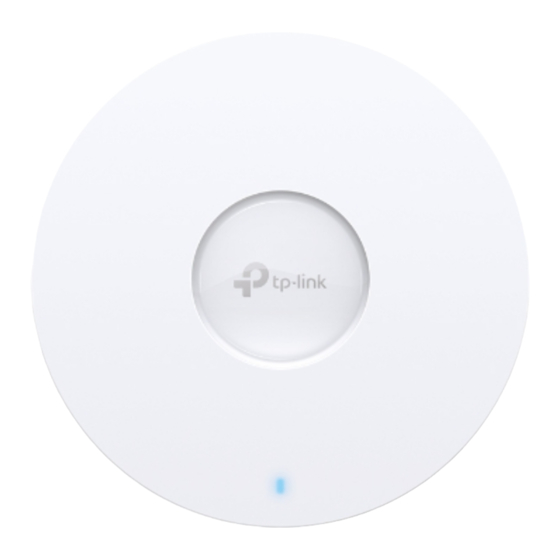
TP-Link Omada EAP660 HD Quick Installation Manual
Hide thumbs
Also See for Omada EAP660 HD:
- User manual (133 pages) ,
- Installation manual (76 pages) ,
- Quick installation manual (12 pages)
Table of Contents
Advertisement
Quick Links
Quick Installation Guide
Wireless Access Point
Setup with videos
Visit https://www.tp-link.com/support/setup-video/ or scan the QR code to search for
the setup video of your product model.
1
Hardware Overview
Note:
For simplicity, we will take EAP660 HD for example throughout the Guide. The image may differ from the actual product.
Front Panel
LED Indicator
On: Working normally/Initializing.
Off: Working abnormally/Power off/LED is turned off.
Flashing:
Initialization: The LED flashes twice after initialization is completed.
Upgrade: The LED flashes once per second while upgrading.
Reset: The LED flashes quickly during the reset. The EAP will then reboot.
Isolated: The LED flashes slowly. The EAP is in the isolated state.
Locate: When the Locate feature is activated in the Omada controller, the LED flashes quickly to locate and
identify the device. The LED will flash for 10 minutes, or you can disable the feature manually to stop it flashing.
Rear Panel
RESET
With the device powered on, press and hold the button for about 5 seconds until the LED flashes quickly . Then release the
button. The device will restore to factory default settings.
Ethernet Port: 2.5G ETH (PoE)
(for EAP660 HD / EAP670)
| ETH (PoE)
The port is used to connect to a router or a switch to transmit data, or to a PSE (Power Sourcing Equipment), such as a PoE switch,
for both data transmission and Power over Ethernet (PoE) through Ethernet cable. The port supports transmission speed of
10/100/1000/2500 Mbps (for EAP660 HD / EAP670) or 10/100/1000 Mbps (for EAP610 / EAP620 HD).
Power Port: 12V
2A
| 12V
1.5A
(for EAP660 HD)
(for EAP670)
Plug one end of the provided power adapter to this port and the other end to a standard electrical wall outlet to power the EAP.
Hardware Installation
2
The EAP can be ceiling-mounted or wall-mounted. Choose a mounting method according to your
needs. Follow the steps below for the appropriate installation.
Option 1: Ceiling Mounting
Option1: Ceiling Mounting
Note: Make sure that the ceiling tile is bigger than the EAP.
Washers (Qty.4)
Drill Hole for Ethernet cable
(for EAP610 / EAP620 HD)
| 12V
1A
(for EAP610 / EAP620 HD)
Option 2: Wall Mounting
M3×30 Pan-head Screws (Qty.4)
Wing Nuts (Qty.4)
1
Remove the ceiling tile.
2
Place the mounting bracket in the center of the
X4
ceiling tile. Mark four positions for the screw
holes and a position for the Ethernet cable hole.
Drill four 4 mm diameter holes for the screws and
a 25 mm diameter hole for the Ethernet cable at
the marked positions.
3
Secure the mounting bracket to the ceiling tile
using four M3x30 pan-head screws, washers and
wing nuts, as shown on the left.
4
Feed the Ethernet cable through the hole and set
the ceiling tile back into place.
5
Connect the Ethernet cable to the Ethernet port.
Attach the EAP to the mounting bracket, then
rotate the EAP until it locks into place, as shown on
the left.
Option2: Wall Mounting
M3×28 Plastic Wall Anchors (Qty.4)
M3×20 Self-tapping Screws (Qty.4)
X4
1
If your Ethernet cable feeds through the wall, you
can position the mounting bracket below the cable
hole. Mark four positions for the screw holes and
then drill four 6 mm diameter holes at the marked
positions.
2
Insert the plastic wall anchors into the 6 mm
diameter holes.
3
Secure the mounting bracket to the wall by driving
the self-tapping screws into the anchors. Make
sure that the shoulders of the mounting bracket are
on the outside.
4
Connect the Ethernet cable to the Ethernet port on
the EAP.
5
Attach the EAP to the mounting bracket, then
rotate the EAP until it locks into place, as shown on
the left.
Advertisement
Table of Contents

Summary of Contents for TP-Link Omada EAP660 HD
- Page 1 Note: Make sure that the ceiling tile is bigger than the EAP. then drill four 6 mm diameter holes at the marked positions. Setup with videos Visit https://www.tp-link.com/support/setup-video/ or scan the QR code to search for the setup video of your product model. Washers (Qty.4) M3×30 Pan-head Screws (Qty.4) Wing Nuts (Qty.4)
- Page 2 Omada Software Controller. b. Launch Omada App and log in with your TP-Link ID. Then go to Cloud Access. A list of controllers that have been bound with your TP-Link ID will appear. Then you can further To manage your devices, Omada Software Controller needs to keep running on your computer.











Need help?
Do you have a question about the Omada EAP660 HD and is the answer not in the manual?
Questions and answers